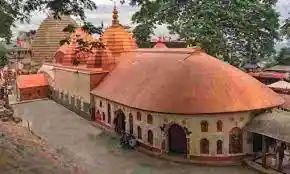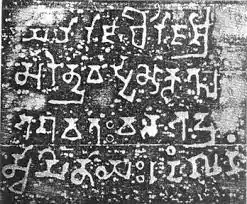The oldest inscription of Assam
Ever visited the Kamakhya temple in Assam? Located in the heart of the Guwahati city on a hilltop, the Kamakhya temple attracts thousands of pilgrims from all over the world. Though the temple is famous for its spirituality, other factors make it a "must visit place". Let us explore one of them.

The Kamakhya temple. Image Source: Sentinel Assam.
The temple has a large number of sculptures and inscriptions, that when observed minutely, tell of the history of this region. One such inscription is the Umachal Rock Inscription. The inscriptions found in Assam belonging to the earlier period are generally found engraved and not written. Interestingly, this is the oldest inscription of Assam.
The Umachal Rock Inscription belonged refers to Maharajadhiraja Surendravarman who can be identified with king Mahendravarman of the Bhauma-Naraka dynasty. It dates back to the 5th century AD and was probably meant to serve the purpose of a signboard for an artificial cave or cave temple constructed by Maharaja Surendravarman for the god Bhagavat Balabhadrasvamin.
The importance of this inscription lies in the fact that Maharaja Suredravarman known from this record was the most powerful king in the Pragjyotisha-Kamrupa area, the ancient name for Assam. He held his head high by not being a tributary king of the Gupta dynasty which held a dominant position over the heart of the Indian subcontinent. He did not even assume the titles of ‘Paramesvara’ or ‘Paramabhattaraka’.
The inscription made it clear that King Mahendravarman was a predecessor of the famous king Bhaskarvarman (of the Varman dynasty in Assam). This is because the rock inscription can be found in the Nilachal Hill, where the famous temple of Kamakhya has been located. Bhaskarvarman’s kingdom included areas where the Bhauma-Naraka kings had their headquarters.
Historians have claimed that it is not completely impossible to denote king Mahendravarman to be a person belonging to the same dynasty because of the uncertainty of the name Surendravarman. He could have been a member of the Varman Dynasty ruling for a small period. But, due to lack of other sources, they have confided themselves into identifying him as Mahendravarman of the Pushyavarma Dynasty.
They have suggested a theory for this calculation. Ancient kings liked to use marvelous titles and often had numerous names recorded on different occasions. They kept on adding titles with each success in their life-may it be a victory over another kingdom or a new administrative policy. These various names often turned into synonyms. The word ‘Mahendra’ means the great Indra while the word ‘Surendra’ means the lord of the Gods. Both these names turn out to be the synonym of Lord Indra.
Mahendravarman’s father was Ganapativarman. He was also called ‘Ganendravarman’. Both the words ‘Ganapati’ and ‘Ganendra’ referred to Lord Ganesha. Keeping the same logic in mind, historians have claimed Surendravarman to be Mahendravarman.
The king mentioned in the Umachal Rock inscription was a devoted worshipper of Bagavat Balabhadrasvamin. This name turns out to be rare in the proximity of Assam during those times since the people here were, mostly, Shakti worshippers. He was not a saint, for sure, as Vaishnavism became popular after the 14th century. Therefore, he can be identified with Balarama or Balabhadra, commonly regarded as the elder brother of Krishna, an incarnation of Vishnu, and worshipped in the eastern part of India.
The independent worship of Balabhadra was rare elsewhere in India. Its occurrence in an inscription of Assam in the 5th century AD is an interesting fact of the religious history of India.
The deity Kamakhya has too offered Assam not only an identity on the basis of spirituality and culture, but also great source of archaeological materials that has enriched the cultural identity of Assam to a great extent.

The text in the Umachal Rock Inscription. Image source: wikipedia


